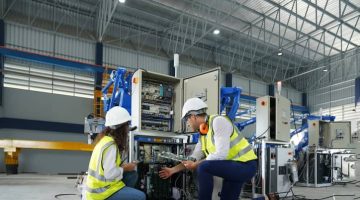In every operation that involves many different processes, tasks and types of equipment, it’s easy to feel overwhelmed by the enormity of the operation. One of the biggest benefits of Lean methodology is how it breaks large, complicated operations into smaller component parts, offering a way to visualize every step.
The tools and techniques of Lean also show how even the largest operation is really the sum of its different parts. One misstep in the smallest task can lead to disastrous consequences that range from slowing production to creating defective products.
A business benefits by catching these issues early. That’s where an Andon Board comes in.
What Is An Andon Board?
An Andon is a signal that alerts those involved in a process that something is working sub-optimally or has stopped working all together. That signal is often transmitted using what is called an Andon Board.
An Andon Board takes many forms. It can be a large light that goes out or one that lights up when there is a problem. An alarm or a message on a large ticker board also can serve as an Andon. Even an automatic text sent to everyone involved in a process within an office can serve as an Andon.
The use of an Andon started as part of the Toyota Production System. An Andon Board on the manufacturing floor keeps workers updated on the status of each portion of the assembly line. It’s a key component of jidoka, the Lean process that allows employees to quickly take action to stop a process when errors are detected.
Automatic vs. Manual Andon
Andon systems fall into two categories: automatic and manual.
A manual system involves the employee who first detects a problem. On a manufacturing floor, they might notice equipment operating outside of acceptable standards of variation. They then must push a button, pull a cord (sometimes referred to as an Andon Cord) or take some type of action to alert everyone of the issue through the Andon.
An automated Andon involves technology (typically something built into a piece of equipment) that senses when there is an issue and sends out an alert, like the “check oil” light on your car. The key advantage here is that no human action is required.
If a business decides to employ a full Andon Board with lights, it typically includes a three-color light scheme to indicate operational status whether it’s automatic or manual.
- Green: Everything is working optimally.
- Yellow: An issue has been detected and a manager is addressing the issue within a set amount of time as dictated by company policy.
- Red: The problem is such that the manager cannot fix it in the time allotted for “yellow light” issues. The process must stop until the problem is corrected.
What Are the Advantages of Andon?
Using Andon offers a wide range of benefits. First or foremost, it creates transparency in any process and improves flow of information. Everyone involved knows the status of a process or project at any given time. That increases efficiency and lowers time spent on wasted efforts. Other benefits include the following.
Lower costs: By catching problems early, Andon helps reduce rework needed to repair or replace defective products.
Increased product quality: This creates happier customers or end users, the goal of every Lean-driven process.
It empowers workers: An Andon system gives workers the right to stop a task if it will negatively impact an entire operation. That leads to empowered workers who are more engaged and committed to creating higher quality products.
Faster turnaround times: When a problem occurs and the Andon alerts everyone, managers and employees involved with the task immediately focus on finding the root cause of the problem and eliminating it.
Continuous improvement: The focus on eliminating waste and mistakes as well as immediately addressing problems creates a culture of continuous improvement, which is one of the goals of a Lean system.
Examples of Andon
In addition to the big board on the manufacturing floor at Toyota, other examples of Andon are around people every day. A car’s system of lights on the dashboard serves as an Andon board. Group emails and text messages that provide daily status updates or alerts when there is an issue are a form of Andon.
Amazon also uses a “Virtual Andon” for its customer service. An automated system alerts customer service representatives when consumers report that a product is defective or does not deliver what the product description promised. Representatives can take action to stop shipment of the product if the problem is recurring.
Also, the Amazon Virtual Andon offers a way to monitor manufacturing workstations, devices, and events with the goals of process optimization, preventing future issues and developing effective predictive maintenance.



